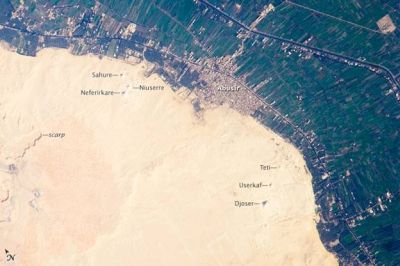15 January 2009

The Royal Necropolis of Sakkara
The image was taken by astronauts aboard the International Space Station
Credit: NASA
NASA recently published a stunning picture showing the vast royal necropolis of Sakkara, where the pyramids of some of Egypt’s greatest kings were built. The detailed image was taken by astronauts working aboard the International Space Station, on 31 October 2008.
The pyramids in the photo include the Step Pyramid of King Djoser (2635-2610 BC), the first Egyptian pyramid ever built, the pyramid of King Userkaf (2465-2458 BC), the pyramid of King Teti (2345-2333 BC) and the pyramids of Abusir.
(The chronology of ancient Egypt is not precise; its dates are considered approximate.)
Most of the Egyptian pyramids are located along the Nile, in the present Giza Governorate, on the western riverbank. They were established on a gravelly desert plateau, overlooking the cultivated river valley. Several cliffs are visible in the image, at lower left.
The Step Pyramid is the dominant feature of the magnificent mortuary complex of King Djoser, believed to be the founder of the Third Dynasty. It is regarded as the earliest large stone structure in history. The Step Pyramid was originally 62 m high, and its base measures about 125 x 109 m.
The village of Abusir is clearly visible as a grey-white irregular urban area that contrasts with green farms of the Nile Delta and tan desert to the west. The splendid Fifth Dynasty necropolis of Abusir is located to the northwest of the village, at image top center. The site of Abusir includes the pyramids of King Sahure (2487-2474 BC), Neferirkare (2474-2464 BC) and King Niuserre (2458-2422 BC). It was likely chosen due to the existence of a lake—now dry—that facilitated transport of building materials for the pyramids and associated structures.
The northern portion of the large necropolis of Sakkara is also visible at image right, south to southwest of the village of Abusir. The largest pyramid in this area is that of King Djoser.
The presence of Fifth Dynasty and Sixth Dynasty pyramids in this region demonstrates the long period of use of the Sakkara necropolis. Astronauts have also taken spectacular images of other pyramid complexes, such as Giza and Dashur.
Further Reading
International Space Station
http://www.nasa.gov/mission_pages/station/main/index.html
Aymen Mohamed Ibrahem
Senior Astronomy Specialist